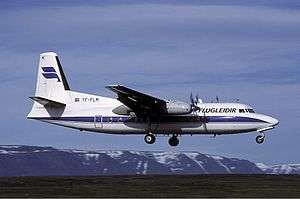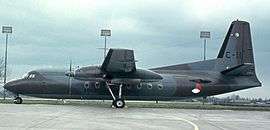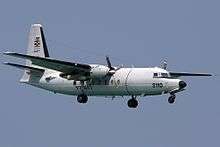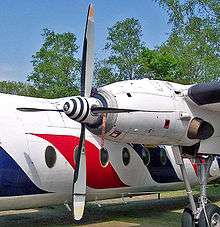Fokker F27 Friendship
| F27 Friendship | |
|---|---|
 | |
| An F27-200 in Iceland (1989) | |
| Role | Airliner |
| National origin | Netherlands |
| Manufacturer | Fokker |
| First flight | 24 November 1955 |
| Introduction | 19 November 1958 |
| Status | Out of production, in active service |
| Produced | 1955–1987 |
| Number built | 586 |
| Unit cost |
-500: US$1.6M (1972)[1] |
| Variants | Fairchild F-27/FH-227 |
| Developed into | Fokker 50 |
The Fokker F27 Friendship is a turboprop airliner developed and manufactured by the Dutch aircraft manufacturer Fokker. It has the distinction of being the most numerous post-war aircraft to have been manufactured in the Netherlands; the F27 was also one of the most successful European airliners of its era.
The F27 was developed during the early 1950s with the expressed intent of producing a capable successor to the earlier piston engine-powered airliners that had become commonplace on the market, such as the successful Douglas DC-3. A key innovation of the F27 was the adoption of the Rolls-Royce Dart turboprop engine, which produced substantially less vibration and noise which provided improved conditions for passengers; another major comfort feature was cabin pressurisation. Innovative manufacturing techniques were also employed in the aircraft's construction.
On 24 November 1955, the F27 performed its maiden flight; on 19 November 1958, the type was introduced to revenue service. Shortly after its introduction, the F27 was recognised as being a commercial success. Under a licensing arrangement reached between Fokker and the U.S. aircraft manufacturer Fairchild, the F27 was manufactured in the United States by the latter; Fairchild went on to independently develop a stretched version of the airliner, which was designated as the Fairchild FH-227. During the 1980s, Fokker developed a modernised successor to the F27, the Fokker 50, which eventually replaced it in production.
Design and development
Origins
In the aftermath of the Second World War, twin-engine all-metal monoplanes such as the successful Douglas DC-3 airliner dominated commuter aviation. Over 10,000 DC-3s had been manufactured during wartime, which led to the type being highly available and thus encouraging its adoption by hundreds of operators across the world.[2]
By the early 1950s, various aircraft manufacturers had begun considering the post-war requirements of the civil aviation market and several commenced work upon projects aiming to produce designs for new aircraft which would be viewed as best meeting these requirements; Dutch firm Fokker was amongst the companies pursuing development of such an aircraft.[2] By 1951, figures within Fokker were urging that design work be undertaken on a prospective 32-seat airliner intended as a direct replacement for the popular DC-3.[3] Fokker sought the opinions of a number of existing DC-3 operators on what performance increases and refinements they would expect of a new model of commuter aircraft. On the basis of this feedback, the design team chose to incorporate various new technologies into the tentative design.[2]
Fokker evaluated a number of different potential configurations for the airliner, including the use of Wright Cyclone radial engines, before finally settling upon a high-wing aircraft, which was furnished with a pair of Rolls-Royce Dart turboprop engines and a pressurised cabin which contained a total of 28 passengers.[2] The Dart engine had already proven successful on the early models of the Vickers Viscount, while a high-mounted wing had been selected as it produced a higher lift coefficient than a lower counterpart, it also enabled easier ground loading due to a lower floor level and provided unfettered external views to passengers without any weight increase. In the aircraft's construction, Fokker used an innovative metal-to-metal bonding technique, Redux, resulting in a longer fatigue life, improved aerodynamics, and a lighter structure; Fokker became the first such company after de Havilland to employ such means.[2]
In 1953, the proposed airliner received the name Friendship.[2] A total of four prototypes were produced, two of these being flyable aircraft that were used for the test flight programme and were paid for by the Netherlands Institute of Aircraft Development; the other two prototypes were for static and fatigue testing.[3] On 24 November 1955, the first prototype, registered PH-NIV, performed its maiden flight.[3] The second prototype and initial production machines were 0.9 m (3 ft) longer than the first prototype in order to addressing a revealed tendency for slightly tail-heavy handling as well as to provide additional space for four more passengers, raising the maximum number of passengers which could be carried to 32. These aircraft were also powered by the Dart Mk 528 engine, which was capable of generating greater thrust.
Further development
Throughout the F27's production life, Fokker proceeded to adapt the design for various purposes and roles.[2] Via a number of modifications, such as the adoption of improved engines, rearranged loading doors, elongated fuselages, and other changes, several different models of the F27 were developed and made available for commercial operators. Several military transport models were also produced. Fokker also chose to design a dedicated model of the F27 for conducting maritime reconnaissance missions.[2][2]
During 1952, Fokker established a relationship with the US aircraft manufacturer Fairchild, which was interested in the upcoming F27.[2] In 1956, Fokker signed a licensing deal with Fairchild, under which the latter was authorised to manufacture the F27 in the USA. On 12 April 1958, the first American-built aircraft conducted its first flight.[2] Production of Fairchild built aircraft would continue until July 1973. Fairchild proceeded to independently develop a stretched version of the airliner, designated as the FH-227. The majority of sales completed by Fairchild fell within the North American market.
In the early 1980s, Fokker decided to develop a modernised successor to the F27 Friendship, designated as the F27 Mark 050 and marketed as the Fokker 50. Although originating from the F27-500 airframe, the Fokker 50 was virtually a new aircraft, complete with Pratt & Whitney Canada engines and modern systems, which led to its general performance and passenger comfort being noticeably improved over the F27.[4] The Fokker 50 ultimately replaced the F27 in production.
Operational history


In November 1958, the first production aircraft, an F27-100 model, was delivered to Irish airline Aer Lingus; it performed its first revenue flight in the following month.[3][2] Other early customers of the Friendship included Braathens SAFE and Luxair in Europe; New Zealand National Airways Corporation; Trans Australia Airlines and its Australian competitors Ansett and East-West Airlines; and Turkish Airlines.
Initial sales for the type were slow, which led to Fokker seeking financial support from banks and from the Dutch government in order to maintain production of the airliner while more customers were sought.[2] In 1960, demand for the F27 increased rapidly as multiple airlines placed sizable orders for the type. This is in part due to the spreading reputation of the type, having been found by operators that, in comparison to its piston-engine wartime counterparts like the DC-3, the F27 possessed superior levels of efficiency, enabling faster flight times, greater passenger comfort and a higher level of reliability.[2]
In 1960, the base purchase price for an RDa.6-powered F27 was £239,000.[5] By the end of the production run for the Fokker F27 in 1987, a total of 592 units had been completed by Fokker (additionally, another 207 F-27s and FH-227s had been produced in the US by Fairchild), more than any other western European civil turboprop airliner at the time.[2]
In later service, many aircraft have been modified from their original configurations for passenger service to perform cargo or express-package freighter duties instead. The last major cargo user of the F27 in the United States was FedEx Express, using it as a cargo "feeder" aircraft. These were retired and replaced by a mixture of ATR 42 and ATR 72 aircraft by the end of 2009, the last of these aircraft were subsequently donated to the Hickory Aviation Museum.
As of July 2010 a total of 65 F27s were in commercial service with almost 30 different airlines.[6] By July 2013, only 25 Friendships remained in service, operated by 13 different airlines; most of these were F27-500s, with two -400s and a solitary -600 series aircraft in service. Italian cargo airline MiniLiner operated six F27s and Air Panama had four in its fleet.[7] The United States Army Parachute Team has operated a single C-31A Troopship for conducting its skydiving exhibitions since 1985.[8][9] As of July 2018, 10 aircraft remain in service operated by 7 airlines.[10]
Variants

- F27-100 - This was the first production model; 44 passengers.
- F27-200 - It was powered by the more powerful Dart Mk 532 engine.
- F27-300 Combiplane - A combined civil passenger/cargo aircraft.
- F27-300M Troopship - Military transport version for Royal Netherlands Air Force.
- F27-400 - "Combi" passenger/cargo aircraft, with two Rolls-Royce Dart 7 turboprop engines and large cargo door.
- F27-400M - Military version for US Army with designation C-31A Troopship, still in use in 2015.
- F27-500 - equipped with a 1.5 m (4 ft 11 in) longer fuselage, a return to the Dart Mk 528 engine, and accommodation for up to 52 passengers. It first flew in November 1967.
- F27-500M - Military version of the -500.
- F27-500F - A version of the -500 for Australia with smaller front and rear doors.
- F27-600 - Quick change cargo/passenger version of -200 with large cargo door.
- F27-700 - A F27-100 with a large cargo door.
- F27 200-MAR - Unarmed maritime reconnaissance version.
- F27 Maritime Enforcer - Armed maritime reconnaissance version.
- F-27 - License-built version manufactured by Fairchild Hiller in the United States
- FH-227 - Stretched version of the F-27, independently developed and manufactured by Fairchild Hiller in the United States
Operators
Notable accidents and incidents
- On 10 June 1960 Trans Australia Airlines Flight 538 crashed in the sea near Mackay, Queensland, Australia. There were 29 fatalities in what is still the deadliest civilian Australian aircraft accident in history. The investigation was not able to determine a probable cause of this accident. The accident was critical in the development of the flight recorder to record parameters to aid investigations of future airliner accidents.
- On 7 May 1964, Pacific Air Lines Flight 773 crashed into a hill in San Ramon, California, after a suicidal passenger killed both pilots and then turned the gun on himself. All 44 people on board were killed.
- On the evening of 15 November 1964, Bonanza Air Lines Flight 114 was flying from Phoenix, Arizona, to McCarran International Airport in Las Vegas, Nevada, in poor weather conditions when it crashed into the top of a hill in open desert country about 10 miles (16 km) SSW of Las Vegas. All 29 people on board—26 passengers and a crew of three—died instantly when the plane exploded on impact, no more than 10 feet (3 m) below a ridge crest. It was Bonanza's only crash with fatalities during the airline's 23-year history.
- On 21 April 1969, an Indian Airlines flight crashed in a thunderstorm while crossing East Pakistan (now Bangladesh) airspace on its flight from Agartala to Calcutta, killing all 44 people on board. [11]
- On 6 August 1970 a Pakistan International Airlines Fokker F27 turboprop aircraft crashed near small village Rawat, after take off from Islamabad in a thunderstorm, killing all 30 people on board.
- On 30 January 1971 Indian Airlines Fokker Friendship aircraft Ganga was hijacked by Hashim Quereshi and his cousin Ashraf Butt and was flown to Lahore, Pakistan where the passengers and crew were released and the aircraft was burnt on February 1, 1971.[12][13][14]
- Pakistan International Airlines Flight 631 crashed on 8 December 1972 near Gilgit, Pakistan: 26 fatalities.
- On 14 September 1978 a Philippine Air Force F27 crashed due to windshear; 15 of the 24 people on board were killed, as well as 17 people on the ground.[15]
- On 29 March 1979 the F27 operating Quebecair Flight 255 crashed minutes after taking off from Québec City Jean Lesage International Airport in Canada. Seventeen people died and seven were injured.
- On 26 May 1980 a Nigerian Air Force F27 crashed due to a thunderstorm, killing all 30 people on board. The aircraft was carrying a delegation of military and government officials on a diplomatic mission.
- On 20 July 1981 Somali Airlines Flight 40 crashed near Balad, Somalia. All 50 passengers and crew on board were killed.
- On 5 August 1984, a Biman Bangladesh Airlines Fokker F27-600 crashed into a marsh near Zia International Airport (now Shahjalal International Airport) in Dhaka, Bangladesh while landing in poor weather.[16] With a total death toll of 49 people, it is the deadliest aviation disaster to occur on Bangladeshi soil.[17]
- On 20 February 1986, Colonel Abdolbaghi Darvish was shot down by an Iraqi fighter jet while flying his Iranian F27-600. All 49 crew and passengers were killed.[18][19] The aircraft was carrying a delegation of military and government officials on a mission.
- On 16 August 1986 a Sudan Airways F27 was shot down by the Sudan People's Liberation Army, killing all 60 people on board.
- On 23 October 1986 a Pakistan International Airlines F27 crashed while coming in to land in the northwestern city of Peshawar, killing 13 of the 54 people on board
- On 8 December 1987 the Alianza Lima air disaster in which an F27 of the Peruvian Navy that was transporting the Alianza Lima football team crashed in Lima, Peru, killing the whole team.
- On 19 October 1988 thirty-four died in a Vayudoot F27 crash near Guwahati, India.[20][21][22]
- On 25 August 1989 a Pakistan International Airlines F27 operating as Pakistan International Airlines Flight 404 and carrying 54 people disappeared after leaving Gilgit in northern Pakistan. The wreckage was never found.
- On 8 November 1995 an Argentine Air Force F27, tail number TC-72, operating a LADE civilian flight from Comodoro Rivadavia to Córdoba, crashed (32°06′44″S 64°56′53″W / 32.112270°S 64.948023°W) near the summit of mount Champaquí in Córdoba, killing all 52 passengers and crew.[23]
- On 17 July 1997 Sempati Air Flight 304 crashed at Bandung, West Java, shortly after take-off when after engine failure the crew mishandled the return to the airport on one engine.
- On 11 November 2002 Laoag International Airlines Flight 585 crashed into Manila Bay in the Philippines; 19 of the 34 people on board were killed.
- On 20 February 2003 a military F27 crashed in northwestern Pakistan, killing Pakistan Air Force Chief, Air Chief Marshal Mushaf Ali Mir, his wife and 15 others.
- Pakistan International Airlines Flight 688 carrying 45 people crashed 2–3 minutes after take off from Multan airport on 10 July 2006. There were no survivors. Engine fire was suspected as the cause of the crash.[24]
- On 6 April 2009 an Indonesian Air Force F27 crashed in Bandung, Indonesia, killing all 24 occupants on board. The cause of the accident was said to be heavy rain.[25] The aircraft reportedly crashed into a hangar during its landing procedure and killed all on board.
- On 21 June 2012 an Indonesian Air Force F27 crashed into a housing complex in the capital Jakarta, setting six houses on fire and killing at least 11 people.[26]
Aircraft on display
- Australia
- 10132 – F27-109 on static display at the South Australian Aviation Museum in Adelaide, South Australia. It was previously operated as VH-CAT by the CSIRO as an atmospheric research aircraft.[27][28]
- 10315 – F27-600QC on static display at the Queensland Air Museum at Caloundra Airport in Caloundra, Queensland. It was originally manufactured as an F27-400 and later redesignated as a -600QC. The aircraft was delivered new to Australia and spent most of its career operating for Ansett.[29]
- 10596 - F27-500 delivered airworthy to the Historical Aircraft Restoration Society, Illawarra Regional Airport, New South Wales on 26 February 2018. Previously operated by Airwork under contract to New Zealand Post.[30]
- Iceland
- 10545 – F27-200-MAR on static display at the Akureyri Aviation Museum at Akureyri Airport. It was previously operated as TF-SYN by the Icelandic Coast Guard.[31][32]
- Netherlands
- 10102 – F27-100 on static display at the Aviodrome in Lelystad. It was previously registered as PH-NVF and is one of the prototype F27s, in which colours it is painted.[33][34]
- 10105 – F27-100 on static display at the Aviodrome. It was previously registered as PH-FHF, is the first production F27, and is painted in the colours of NLM CityHopper.[33][35][36]
- 10449 – F27-500 on static display at Fokker Logistics Park in Oude Meer. It was previously registered as N19XE and is painted as PH-NIV, the first prototype F27. It marks the former location of the Fokker factory at Amsterdam Airport Schiphol.[37][38]
- C-10 – F27-300M on static display at the Militaire Luchtvaart Museum in Soesterberg, Utrecht.[39][40]
- New Zealand
- 10189 – F27-100 on static display at the Ferrymead Aeronautical Society in Ferrymead Heritage Park in Christchurch. It was previously operated as ZK-BXG and is painted in National Airways Corporation colours.[41]
- 10190 – F27-100 on static display at the National Transport and Toy Museum, Wanaka. It was previously registered as ZK-BXH.[42][43]
- 10286 – F27-100 under restoration at the Chatham Islands Aviation Museum in Waitangi, Chatham Islands. It was previously registered as ZK-BXI.[44][45][46]
- United Kingdom
- 10196 – F27-200 on static display at the City of Norwich Aviation Museum in Horsham St Faith. It was previously operated as G-BHMY by Air UK.[47][48]
- 10201 – F27-500 on static display at the City of Norwich Aviation Museum. It was previously operated as G-BCDN by Air UK before being retired to the KLM UK Engineering Technical College at Norwich Airport.[49]
- United States
- 10367 – F27-500 on static display at the Hickory Aviation Museum in Hickory, North Carolina. It was previously operated as N705FE by FedEx.[50][51]
Specifications (F.27)



Data from The Observers Book of Aircraft[52]
General characteristics
- Crew: 2 or 3
- Capacity: 48-56 passengers
- Length: 25.06 m (82 ft 3 in)
- Wingspan: 29 m (95 ft 2 in)
- Height: 8.72 m (28 ft 7 in)
- Wing area: 70 m2 (750 sq ft)
- Empty weight: 11,204 kg (24,701 lb)
- Max takeoff weight: 19,773 kg (43,592 lb)
- Powerplant: 2 × Rolls-Royce Dart Mk.532-7 two-stage centrifugal compressor turboprop, 1,678 kW (2,250 hp) each
Performance
- Cruise speed: 460 km/h (286 mph; 248 kn)
- Range: 2,600 km (1,616 mi; 1,404 nmi)
- Rate of climb: 7.37 m/s (1,451 ft/min)
See also
Related development
Aircraft of comparable role, configuration and era
Related lists
References
Citations
- ↑ "Airliner price index". Flight International. 10 August 1972. p. 183.
- 1 2 3 4 5 6 7 8 9 10 11 12 13 14 15 "Significant Aircraft Profiles: F27 Fokker Friendship." South Australian Aviation Museum, Retrieved: 24 March 2017.
- 1 2 3 4 "Commercial Aircraft of the World..." Flight International, 26 November 1964. p. 917.
- ↑ Eriksson and Steenhuis 2015, p. 44.
- ↑ "fokker - fairchild - 1960 - 2694". Flight International. Retrieved 13 November 2014.
- ↑ "2010 World Airliner Census", p. 44.
- ↑ "2013 World Airliner Census", p. 57.
- ↑ "Aircraft". U.S. Army Parachute Team "Golden Knights". Archived from the original on 16 January 2014. Retrieved 19 January 2014.
- ↑ "Fokker C-31A Troopship, U.S. ARMY GOLDEN KNIGHTS' s aircraft landing." youtube.com, 25 Aug 2015.
- ↑ "World Airline Census 2018". Flightglobal.com. Retrieved 2018-08-26.
- ↑ Aviation-Safety.net
- ↑ "Who was behind hijacking of IA plane 'Ganga'?". Archived from the original on 13 November 2014. Retrieved 13 November 2014.
- ↑ "Did India plant 1965 war plans?". Rediff.com. Retrieved 2012-07-05.
- ↑ "Hijack into terror". The Times Of India. October 6, 2001.
- ↑ "ASN Accident Description". Aviation Safety Network. 14 September 1978. Retrieved 21 January 2017.
- ↑ Accident description for S2-ABJ at the Aviation Safety Network
- ↑ "AROUND THE WORLD; 49 Die in Bangladesh As Plane Plunges". The New York Times. 6 August 1984. Retrieved 14 August 2014.
- ↑ http://www.acig.org/artman/publish/article_404.shtml
- ↑ Iran-Iraq War of 1980-1988,Tom Cooper, Farzad Bishop , 2000 - pages-211
- ↑ Archived April 8, 2008, at the Wayback Machine.
- ↑ "Air Disaster.com". Air Disaster.com. Retrieved 2012-07-05.
- ↑ Crossette, Barbara (1990-02-15). "NY Times". New York Times. Retrieved 2012-07-05.
- ↑ "Article about TC-72". Diario Crónica, Comodoro Rivadavia. Archived from the original on 2012-04-26.
- ↑ "South Asia | No survivors in Pakistani crash". BBC News. 2006-07-10. Retrieved 2012-07-05.
- ↑ Govindasamy, Siva (2009-04-07). "VIDEO: Indonesian military Fokker F-27 crashes in Bandung - Asian Skies". Flightglobal.com. Retrieved 2012-07-05.
- ↑ "detikNews : Korban Rumah Terbakar Akibat Fokker 27 Ngungsi ke Rumah Dinas TNI AU". News.detik.com. 2012-06-22. Archived from the original on 2013-10-05. Retrieved 2012-07-05.
- ↑ "FOKKER F27-109 FRIENDSHIP VH-CAT". South Australian Aviation Museum. South Australian Aviation Museum. Retrieved 12 April 2017.
- ↑ "Fokker F.27 Friendship VH-CAT". The Airways Museum & Civil Aviation Historical Society. Retrieved 12 April 2017.
- ↑ "Fokker F.27 Friendship Mk. 400 VH-FNQ c/n 10315". qam.com.au. Queensland Air Museum. Retrieved 26 February 2018.
- ↑ "A Fokker Friendly [sic] will be the new addition at Albion Park's Historical Aircraft Restoration Society". Illawarra Mercury. 26 February 2018. Retrieved 26 February 2018.
- ↑ Walton, John (25 September 2015). "Iceland's Aviation Museum Glows with History and Heritage". Airways. Airways International, Inc. Retrieved 12 April 2017.
- ↑ "Airframe Dossier - Fokker F-27-200-mar, c/n 10545, c/r TF-SYN". Aerial Visuals. AerialVisuals.ca. Retrieved 12 April 2017.
- 1 2 "FOKKER F.27 FRIENDSHIP". Aviodrome (in Dutch). Retrieved 12 April 2017.
- ↑ "Airframe Dossier - Fokker F-27-100, c/n 10102, c/r PH-NVF". Aerial Visuals. AerialVisuals.ca. Retrieved 12 April 2017.
- ↑ Smith, Bob. "VH-NLS. Fokker F.27-1001. c/n 10105". AussieAirliners. Retrieved 12 April 2017.
- ↑ "Airframe Dossier - Fokker F-27-100, c/n 10105, c/r PH-FHF". Aerial Visuals. AerialVisuals.ca. Retrieved 12 April 2017.
- ↑ van Drunen, Mark; Beekmans, Rob. "THE STORY OF 10449, "THE GATEGUARD"". The Fokker Aircraft Page. Retrieved 12 April 2017.
- ↑ "FAA REGISTRY [N19XE]". Federal Aviation Administration. U.S. Department of Transportation. Retrieved 12 April 2017.
- ↑ "Fokker F27 aircraft carried to the museum by van der Vlist." Heavy Lift News, Retrieved: 24 Match 2017.
- ↑ "Airframe Dossier - Fokker F-27-300M Troopship, s/n C-10 KLu, c/r PH-FBY". Aerial Visuals. AerialVisuals.ca. Retrieved 12 April 2017.
- ↑ "Fokker Friendship ZK-BXG". Ferrymead Aeronautical Society. Retrieved 11 April 2017.
- ↑ Smith, Bob. "VH-EWH. Fokker F.27-1020. c/n 10190". AussieAirliners. Retrieved 12 April 2017.
- ↑ "Aircraft ZK-BXH Data". Airport-Data.com. Airport-Data.com. Retrieved 12 April 2017.
- ↑ Williams, Al (1 November 2012). "Final flight plain sailing for old bird". Stuff. Fairfax New Zealand Limited. Retrieved 11 April 2017.
- ↑ "Airframe Dossier - Fokker F27-100 Friendship, c/r ZK-BXI". Aerial Visuals. AerialVisuals.ca. Retrieved 12 April 2017.
- ↑ "ZK-BXI Air New Zealand". OneSpotter. flash. Retrieved 12 April 2017.
- ↑ "Fokker F27 Friendship Serial G-BHMY". City of Norwich Aviation Museum. GP Digital. 24 May 2012. Archived from the original on 12 April 2017. Retrieved 11 April 2017.
- ↑ "Airframe Dossier - Fokker F-27, c/n 10196, c/r G-BHMY". Aerial Visuals. AerialVisuals.ca. Retrieved 12 April 2017.
- ↑ "Fokker F27 Friendship Serial G-BCDN". Air UK Reunion. Carl France. Retrieved 14 October 2017.
- ↑ "Fokker F27 “Friendship”." Hickory Aviation Museum, Retrieved: 24 Match 2017.
- ↑ "FAA REGISTRY [N705FE]". Federal Aviation Administration. U.S. Department of Transportation. Retrieved 11 April 2017.
- ↑ Green, William. The Observers Book of Aircraft. Frederick Warne & Co. Ltd, 1970. ISBN 0-7232-0087-4.
Bibliography
- "2010 World Airliner Census." Flight International, Retrieved: 21 January 2014.
- Eriksson, Sören and Harm-Jan Steenhuis. The Global Commercial Aviation Industry. Routledge, 2015. ISBN 1-13667-239-7.
- "World Airliner Census". Flight International, Volume 184, Number 5403. 13–19 August 2013, pp. 40–58.
External links
| Wikimedia Commons has media related to Fokker F-27. |
- Stork Aerospace Homepage
- F27 Friendship Association
- Photo Gallery (in Dutch) (in English)
- Fokker F27 Info